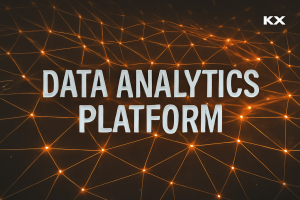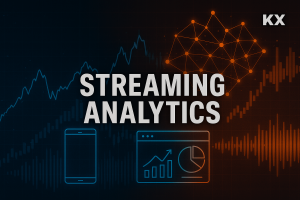Key Takeaways
- Big data analytics refers to techniques for extracting insights from large, fast-moving, and complex datasets.
- It supports real-time decision-making by processing both historical and streaming data.
- Time-series analysis is a core component of big data analytics in capital markets and other data-intensive industries.
- Performance, scale, and low-latency processing are critical for analytics platforms operating in high-frequency environments.
- When implemented strategically, big data analytics improves operational efficiency, risk visibility, and competitive response time.
Big data analytics refers to the methods and technologies used to process, analyze, and extract value from large and complex datasets. These techniques allow organizations to detect patterns, generate insights, and support decision-making at scale. While many industries use big data analytics to improve operations and customer outcomes, its role is especially critical in environments where data moves fast, changes often, and demands immediate action, such as capital markets, energy trading, and other real-time domains.
Understanding big data analytics
Big data analytics refers to the techniques used to extract insights from datasets that are too large, fast-moving, or complex for traditional data processing systems. These datasets often span both structured and unstructured sources and may include historical archives as well as live, high-frequency data streams.
What sets big data analytics apart is its ability to operate at scale, processing billions of data points to detect patterns, correlations, and anomalies that inform business decisions. In domains like capital markets, this means analyzing real-time market data, order flows, and risk exposures without delay.
Common big data analytics techniques include distributed computing, time-series analysis, machine learning, and stream processing. When deployed effectively, these methods help organizations uncover actionable intelligence and respond to changing conditions faster than manual analysis ever could.
How big data analytics drives business value
Big data analytics helps organizations unlock value from large and complex datasets by turning raw information into real-time, actionable insight. For capital markets firms, this translates to faster execution, better risk management, and improved surveillance across the trade lifecycle.
By analyzing both historical and streaming data, teams can detect anomalies, identify pricing inefficiencies, and generate signals for trading or portfolio optimization. Risk teams use analytics to monitor exposure in near real time, while compliance functions apply it to detect suspicious behavior or potential policy breaches.
Beyond finance, industries like energy, manufacturing, and telecom rely on big data analytics to improve operational efficiency, predict equipment failures, and optimize resource allocation. In each case, success depends not just on the volume of data, but on the ability to process and interpret it at speed.
Industries transformed by big data analytics
Big data analytics is critical in industries where performance, precision, and data velocity directly impact outcomes.
In capital markets, it supports trading strategies, real-time risk assessment, and regulatory compliance. Firms rely on the ability to process billions of data points each day, including market feeds, order flows, and news sentiment, to detect patterns, spot anomalies, and drive faster decisions.
Energy companies use analytics for live demand forecasting, predictive maintenance, and optimization of grid operations. These capabilities help reduce downtime, manage volatility, and ensure resource efficiency.
Telecommunications providers apply analytics to monitor network performance, prevent fraud, and deliver personalized services based on usage behavior across large customer bases.
What connects these sectors is a shared requirement: the ability to analyze large volumes of time-sensitive data and act on it immediately. High-performance platforms like KX provide the speed, scalability, and data integrity needed to meet that challenge.
Business benefits and ROI of big data analytics
Big data analytics delivers measurable value when applied strategically. In capital markets and other data-intensive industries, it helps firms improve decision-making, streamline operations, and respond faster to emerging risks or opportunities.
Key benefits include:
- Faster decision-making: Analytics accelerates insight generation by processing high-volume data in real time
- Cost efficiency: Automated workflows reduce manual effort and optimize resource allocation across teams
- Improved risk visibility: Predictive models help identify anomalies and assess exposure before issues escalate
- Regulatory compliance: Analytics supports surveillance and reporting processes while maintaining auditability
- Operational agility: Teams can adapt quickly to market shifts or new data sources without overhauling core systems
- Revenue growth: Insights from behavioral and transactional data enable smarter pricing, personalization, and portfolio optimization
Organizations that embed analytics into core processes gain long-term advantages in performance, resilience, and responsiveness. These outcomes compound over time, making big data analytics a foundational investment rather than a tactical add-on.
Overcoming challenges in big data analytics implementation
Deploying big data analytics at scale requires more than just technical tools. Success depends on data readiness, infrastructure maturity, and alignment between business and engineering teams. Common challenges include:
- Data quality and consistency: Poor source data can distort results. Firms need strong validation, cleansing, and enrichment processes to ensure reliable inputs.
- Integration with legacy systems: Many capital markets firms rely on siloed platforms that complicate data access and orchestration. Careful planning and modular architectures can ease the transition.
- Skill gaps: Analytics initiatives require a blend of data science, engineering, and domain knowledge. Teams need the right mix of statistical fluency, real-time systems expertise, and business context.
- Compliance complexity: Regulations like MiFID II, GDPR, and CFTC rules create strict requirements for data traceability and governance. Analytics platforms must support transparency, auditability, and control.
- Performance constraints: High-volume environments can strain traditional systems. Low-latency processing and efficient data handling are essential for firms that operate in real time.
- Change management: Embedding analytics into workflows requires cultural shift, executive sponsorship, and consistent communication across teams.
Addressing these challenges early helps ensure that analytics initiatives deliver measurable business value without compromising compliance or system performance.
The future of big data analytics
Big data analytics is evolving from a specialized function into a foundational layer of enterprise operations. For firms managing high-volume, time-sensitive data, the future of analytics lies in systems that are faster, more adaptive, and more transparent.
One major shift is the move toward real-time processing as standard practice. Instead of waiting for overnight batch jobs, organizations increasingly require systems that analyze and act on data the moment it arrives. This shift is especially critical in environments like trading, where milliseconds influence outcomes.
Another development is the rise of edge analytics. By processing data closer to its source—whether in exchanges, IoT devices, or branch locations—organizations reduce latency and improve resiliency.
Automation is also gaining ground. Routine tasks such as data transformation, validation, and enrichment are increasingly handled by machine learning models or predefined logic, allowing analysts and developers to focus on higher-value work.
At the same time, explainability has become a priority. As analytics influences decisions across risk, compliance, and operations, stakeholders need to understand how models produce outcomes. Transparent systems are no longer a nice-to-have—they are essential for trust and regulatory alignment.
Finally, infrastructure is becoming more dynamic. Cloud-native and hybrid environments allow teams to scale analytics on demand and deploy updates faster, without being tied to legacy architectures.
These trends reflect a broader reality: analytics is no longer a siloed toolset. It is embedded into how modern firms operate, compete, and adapt.
Embracing big data analytics for long-term success
Organizations that treat big data analytics as a core capability are better positioned to scale performance, reduce risk, and respond to change.
Successful firms invest in the entire data lifecycle, from high-quality ingestion and normalization to real-time analysis and system-wide observability. They align analytics programs with clear business objectives, whether improving trading execution, strengthening surveillance, or accelerating model development.
Crucially, these organizations embed analytics into operational workflows. Rather than isolating analytics in a dedicated team, they give developers, risk managers, and domain experts access to shared tools and data models. This structure helps surface insights faster and ensures decisions are based on a consistent view of the truth.
Long-term success also depends on adaptability. As markets, regulations, and technologies shift, analytics systems must evolve. Scalable infrastructure, governed self-service, and continuous improvement all contribute to building resilience over time.
Firms that approach big data analytics with this level of discipline and integration build a lasting advantage.
Frequently Asked Questions
Traditional analysis works with smaller datasets using structured models and static reports. Big data analytics processes high-volume, high-velocity, and often unstructured data. It enables pattern detection, forecasting, and decision support in real time.
Looking to scale big data analytics for real-time decision-making?
Explore how KX supports capital markets firms with high-performance analytics for streaming, historical, and time-series data.





